eastern tent caterpillar moth
(Malacosoma americana)
Conservation • Description • Habitat • Ecology • Distribution • Taxonomy
|
|
|||||||||||||||||
Description |
Eastern tent caterpillar moth is a common, well known, medium-sized, lappet moth. It occurs in the United States and southern Canada east of the Great Plains, and there are scattered records in the west. It is very common in Minnesota. The larvae feed on the leaves and buds of trees. Their preferred host by far is black cherry, followed by apple, chokecherry, American plum, and hawthorn. When their favorite trees are defoliated, late stage (instar) caterpillars may move to other, less desirable, deciduous trees. Final instar caterpillars are indiscriminate in their food choice, and they have been recorded feeding on a large number of species. Adults are short lived, lasting only a few days at most. They have non-functional mouth parts and they do not feed. Eastern tent caterpillar moth is not considered a pest. A large infestation can completely defoliate a tree. However, the caterpillar is easily controlled in commercial black cherry orchards by the insecticides already used to control more serious pests, and its other hosts have little economic value. Adults are ⅝″ to 15 ⁄16″ (15 to 24 mm) in length and have a ⅞″ to 1¾″ (22 to 44 mm) wingspan. Females are much larger than males. The body is stocky and extremely hairy. The wings are held tent-like over the body when at rest. The forewings are rounded at the tip. The color is variable, ranging from light brown to “warm fawn brown” to dark chocolate brown. They tend to be darker and more brownish in the male, lighter and more yellowish on the female. They are crossed by two cream colored (pale), oblique, straight or slightly bowed lines: the antemedial line (AM line), between the basal and median areas; and the postmedial line (PM line), that separates the median area from the postmedial area. The median area, between the AM and PM lines, is sometimes paler than the rest of the wing. There are no other distinctive markings. The fringe is pale with one large and a few small dark patches. The hindwings of both sexes are the same color as the forewings. They usually have no pale markings, but sometimes they are crossed by a single, diffuse, pale line. The mature caterpillar is up to 2¼″ (57 cm) long. It is black and steel blue with orange and white markings and an apparently continuous creamy white stripe down the middle (middorsal). The body is covered with medium-length pale and orange hairs. Eastern tent caterpillar is usually identified by the conspicuous, white, tent-like nest it creates in the crotch of two or three branches. |
Size |
Total length: ⅝″ to 15 ⁄16″ (15 to 24 mm) Wingspan: ⅞″ to 1¾″ (22 to 44 mm) |
Similar Species |
Habitat |
Anywhere the host species are found |
Ecology |
Season |
One generation per year: Late June to early July |
Behavior |
Adults are active at night and will come to lights. The wings are held tent-like over the body when at rest. The larvae do not feed in the tent. They spin a strand of silk as they crawl to a neighboring branch, then use the strand to return to the tent after feeding. |
Life Cycle |
The female lays a mass of usually 150 to 200 eggs, sometimes many more. The egg mass is usually laid on a twig, and it almost completely encircles the twig. Sometimes, an egg mass is laid about six inches above the ground on the trunk of a small tree, the diameter of which is no more than 1½″. The larvae develop fully, enter a period of decreased activity (diapause) for a few months, become inactive, and overwinter, all within the egg case. The larvae emerge the following spring about the same time as new leaves appear on the host tree. They immediately begin feeding on leaves and buds, and soon build a tent-like nest. The tent is often built in the crotch formed by two or three substantial branches. After 4 to 8 weeks, depending on the temperature, final instar caterpillars construct a cocoon and pupate. Adults emerge about two weeks later. |
Larva Hosts |
Black cherry is the preferred host, followed by apple, chokecherry, American plum, and hawthorn. Final instars are indiscriminate, feeding on a large number of species. |
Adult Food |
Adults do not feed. |
Distribution |
||
|
Sources |
|
| 7/14/2024 | ||
Occurrence |
||
Very common |
||
Taxonomy |
|
Order |
|
Superfamily |
Lasiocampoidea |
Family |
Lasiocampidae (lappet moths) |
Subfamily |
Lasiocampinae |
Tribe |
Lasiocampini |
Genus |
Malacosoma (tent caterpillar moths) |
Subfamily Species epithet Eastern tent caterpillar moth was originally described as Bombyx americana by Fabricius in 1793. The genus Bombyx was defined very broadly. In 1820, the genus Malacosoma was erected specifically for tent-making caterpillars. Following the move, the species epithet was changed to americanum in order to agree in neuter gender of the new genus name. Authoritative sources are not in agreement about the correct species epithet of eastern tent caterpillar moth. GBIF, Catalogue of Life, BugGuide, Moth Photographers Group, NatureServe, iNaturalist, and Minnesota Biodiversity Atlas use the name Malacosoma americana. ITIS, NCBI, Discover Life, Butterflies and Moths of North America, and Wikipedia use the name Malacosoma americanum. |
|
Subordinate Taxa |
|
|
|
Synonyms |
|
Bombyx americana Bombyx frutetorum Bombyx pensylvanica Clisiocampa decipiens Clisiocampa frutetorum Malacosoma americanum Malacosoma pensylvanica |
|
Common Names |
|
eastern tent caterpillar (larva) eastern tent caterpillar moth (adult) |
|
Glossary
Antemedial (AM) line
A thin line separating the basal area and the median area of the forewing of Lepidoptera.
Diapause
A period of decreased metabolic activity and suspended development.
Instar
The developmental stage of arthropods between each molt; in insects, the developmental stage of the larvae or nymph.
Postmedial (PM) line
A thin line separating the median area and the postmedial area of the forewing of Lepidoptera.
Visitor Photos |
||
Share your photo of this insect. |
||
This button not working for you? |
||
Luciearl |
||
 |
|
|
Bill Reynolds |
||
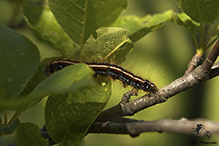 |
|
|
MinnesotaSeasons.com Photos |
||
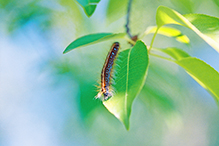 |
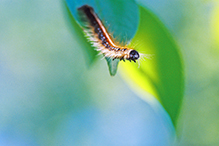 |
|
Caterpillar |
Caterpillar | |
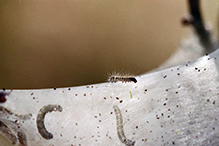 |
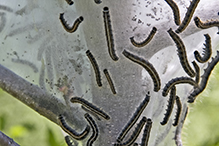 |
|
Caterpillar |
Nest | |
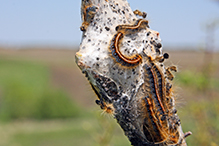 |
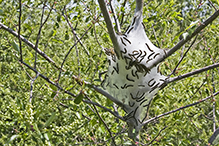 |
|
Nest |
Nest | |
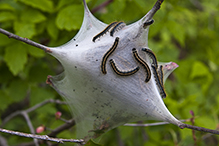 |

Slideshows |
Eastern Tent Moth |
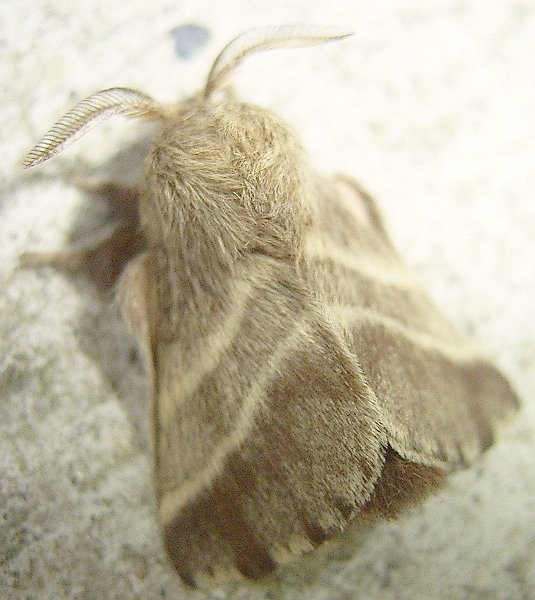
|
About
Copyright DianesDigitals |
Eastern tent caterpillar (Malacosoma americanum) |

|
About
en.wikipedia.org/wiki/Eastern_tent_caterpillar |
Malacosoma americanum (Eastern Tent Caterpillar Moth) |

|

Visitor Videos |
||
Share your video of this insect. |
||
This button not working for you? |
||
|
Other Videos |
||
Macro of Hundreds of Caterpillars ~ Tenting & eating! |
About
Uploaded on May 14, 2010 Macro of Hundreds of Caterpillars ~ Tents & eating! On May 13, 2010 we came across many bushes with a 'bloom' of Western Tent Caterpillars. Opportunity for Sony Macro HD Video - I love to film nature. It's something that is readily doable by anyone with a good consumer handycam, the Sony especially captures great clarity and detail with it's lens. Tent caterpillars are readily recognized because they are social, colorful, diurnal and build conspicuous silk tents in the branches of host trees. Some species, such as the eastern tent caterpillar, Malacosoma americanum, build a single large tent which is typically occupied through the whole of the larval stage while others build a series of small tents that are sequentially abandoned. The forest tent caterpillar moth, Malacosoma disstrium, is exceptional in that the larvae build no tent at all, aggregating instead on silken mats that they spin on the leaves or bark of trees. Tents facilitate aggregation and serve as focal sites of thermal regulatory behavior. Tent caterpillars hatch from their eggs in the early spring at the time the leaves of their host trees are just unfolding. The caterpillars establish their tent soon after they enclose. The tent is constructed at a site that intercepts the early morning sun. The position of the tent is critical because the caterpillars must bask in the sun to elevate their temperatures above the cool ambient temperatures that occur in the early spring. Studies have shown that when the body temperature of a caterpillar is less than about 15 °C, digestion cannot occur. The tent consists of discrete layers of silk separated by gaps and the temperature in these compartments varies markedly. Caterpillars can adjust their body temperatures by moving from one compartment to another. On cool mornings they typically rest in a tight aggregate just under a sunlit surface of the tent. It is not uncommon to find that the temperature of the aggregate is as much as 30 °C (54 °F) warmer than the surrounding air temperature on cold but sunny spring mornings. Later on in the spring, temperatures may become excessive at mid day and the caterpillars may retreat to the shaded outside surface of the tent to cool down. |
Nancy Today: where tent caterpillars come from ASMR |
About
Uploaded on May 2, 2008 finding capsules where the eggs are laid is easy. Just look down the branch the coccoon nest is built on. |
Eastern Tent Caterpillar Moth (Lasiocampidae: Malacosoma americanum) Lateral View |
About
Uploaded on Jul 13, 2011 Photographed at Larimore, North Dakota (13 July 2011). |
Eastern tent caterpillars |
About
Published on Apr 22, 2012 Eastern tent caterpillars (Malacosoma americanum) may be the only insects recognized by their homes rather than their appearance. These sociable caterpillars live together in silk nests, which they build in the crotches of cherry and apple trees. Eastern tent caterpillars may be confused with gypsy moths, or even fall webworm. (From About.com) |
Dr. Rana Sarfraz: Tent caterpillar invasion hits BC gardens. |
About
Published on Sep 20, 2012 Published on Sep 20, 201 |

Visitor Sightings |
||
Report a sighting of this insect. |
||
This button not working for you? |
||
Luciearl |
Location: Cass County |
 |
| Bill Reynolds 5/31/2017 |
Location: Penninton Co. MN |
 |
| Jinmn 5/21/2016 |
Location: Backus (Cass County) 2 large tents on pink Crabapple tree, caterpillars only |
| Paul Stewart 5/18/2016 |
Location: Rush City, MN. Infested our crab apple and plum trees within a day or two. Have never seen them before until today. |
|
MinnesotaSeasons.com Sightings |
||

Created: Last Updated: © MinnesotaSeasons.com. All rights reserved. |
